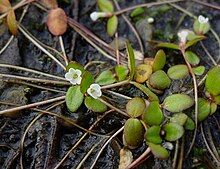Gratiola amphiantha
| Gratiola amphiantha | |
|---|---|
 |
|
| Scientific classification | |
| Kingdom: | Plantae |
| (unranked): | Angiosperms |
| (unranked): | Eudicots |
| (unranked): | Asterids |
| Order: | Lamiales |
| Family: | Plantaginaceae |
| Genus: | Gratiola |
| Species: | G. amphiantha |
| Binomial name | |
|
Gratiola amphiantha D.Estes & R.L.Small 2008 |
|
| Synonyms | |
|
Amphianthus pusillus Torr. |
|
Amphianthus pusillus Torr.
Gratiola amphiantha is a rare species of flowering plant known by the common names little amphianthus, pool sprite and snorkelwort. It was previously the only species in the monotypic genus Amphianthus, but it was moved to genus Gratiola after genetic analysis in 2008. It is native to the Piedmont region of the southeastern United States, with a center of distribution in Georgia. It occurs in Alabama and South Carolina as well. It is limited to granite outcrops, a high-biodiversity habitat type that is threatened by activities such as quarrying, off-road vehicles, and trash and debris dumping. It is a federally listed threatened species.
Gratiola amphiantha is a petite aquatic plant which occurs in the non-Mediterranean climate vernal pools that sometimes form in the granite outcrop habitat. It is a delicate annual herb a few centimeter long with a short, threadlike stem surrounded by a rosette of tiny lance-shaped submerged leaves. Above them are a pair of slightly larger, floating leaves which are oval in shape and up to 8 millimeters (0.3 inches) long. Flowers occur in the axils of both submerged and floating leaves. Those occurring underwater are cleistogamous and do not open, and those blooming on the water's surface have open five-lobed white corollas a few millimeters long. It is a fast-growing species, germinating immediately with sufficient rain and maturing to flower in 17 days. Its life cycle is quick because appropriate growing conditions occur for only a brief time at these pools.
There are few other plants that grow in the vernal pools of the outcrops, except for local endemic species of Isoëtes, such as Isoetes piedmontana.
...
Wikipedia

